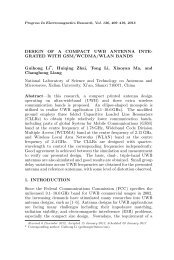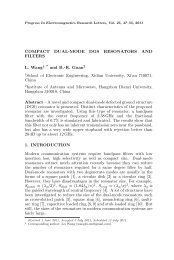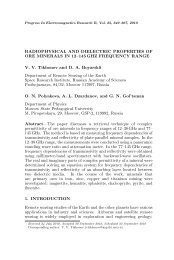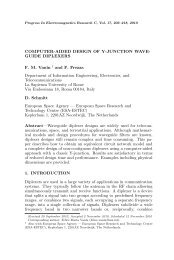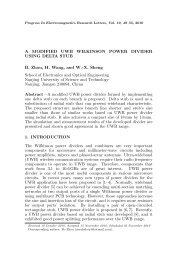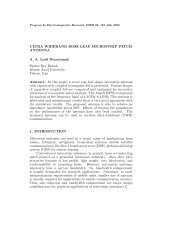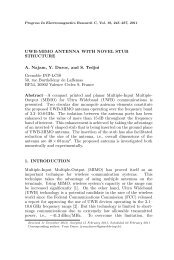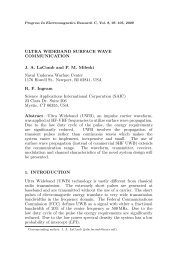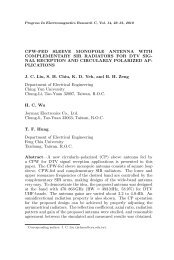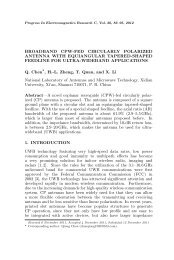ULTRA-WIDEBAND SLOTTED DISC ANTENNA COM ... - PIER
ULTRA-WIDEBAND SLOTTED DISC ANTENNA COM ... - PIER
ULTRA-WIDEBAND SLOTTED DISC ANTENNA COM ... - PIER
Create successful ePaper yourself
Turn your PDF publications into a flip-book with our unique Google optimized e-Paper software.
54 Gomez-Nuñez et al.<br />
antennas need an external tuning circuit and, as shown in [5–7], have<br />
additional power consumption. This takes time to adjust the system<br />
to a desired band. Also, the complexity and number of components<br />
required for the integration into the terminal are increased. The<br />
implementation of multiple antennas raises cost, power consumption,<br />
and increases space for each additional element [8, 9].<br />
Another option is to use a multiband antenna. This alternative<br />
is presented in [10, 11]. However, this type of antennas increases the<br />
complexity of designing and manufacturing when the number of bands<br />
is large.<br />
In this paper, to overcome many of the disadvantages explained<br />
above, the proposed antenna is an UWB antenna, which radiator is<br />
based on a circular patch, since it is easier to design and manufacture<br />
due to the simplicity of the geometry. However, to achieve matching<br />
all over the frequencies of interest, the antenna geometry is modified<br />
in order to obtain the required impedance.<br />
Although, most of the UWB antennas for communication systems<br />
are designed to operate from 3.1 to 10.6 GHz, since this is the<br />
band the Federal Communications Commission has established for<br />
ultra-wideband systems. The proposed antenna works from 0.77 to<br />
11.23 GHz, so a cognitive radio can use several bands as do: GSM 800,<br />
GSM 900, GSM 1800, GSM 1900, WLAN-2.4, WLAN-5.2, or another<br />
standard that works in this range.<br />
The proposed UWB antenna is based on a disc monopole,<br />
because this is the radiator shape that is the most commonly used to<br />
develop monopole antennas for UWB communications systems. Some<br />
results of operating as monopole, the antenna has a wide bandwidth,<br />
omnidirectional pattern, linear polarization and are simple structures<br />
easy to manufacture [12].<br />
One of the most important parameters in a disc monopole is the<br />
radius of the disc, because it determines the lower cutoff frequency.<br />
In [13] the numerical analysis is presented in order to obtain the lower<br />
edge from the radio of the disc.<br />
In the proposed UWB antenna, the disc monopole radiator has<br />
been modified, as well as the ground plane in order to obtain the<br />
desired features, as will be shown in the next sections.<br />
2. <strong>ANTENNA</strong> DESIGN<br />
The monopole is depicted in Fig. 1. As mentioned above, the geometry<br />
of the proposed UWB antenna is based on a disc monopole antenna,<br />
which was designed according to [13], for a lower cutoff frequency of<br />
0.62 GHz, where an antenna of size W = 120 mm by L = 150 mm





